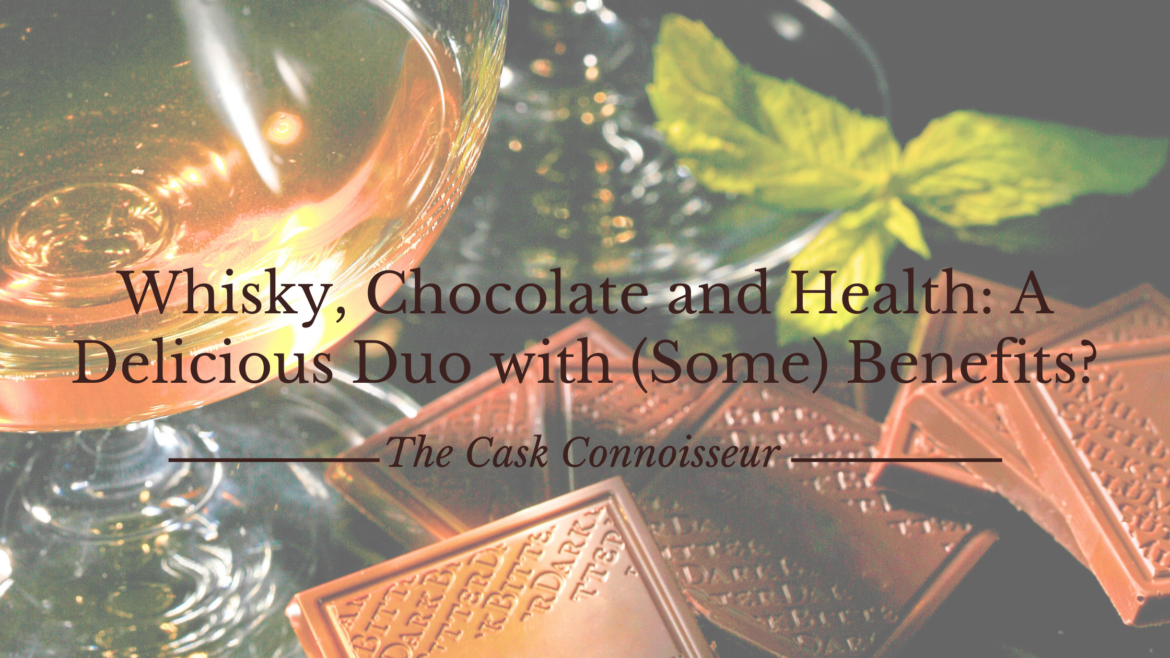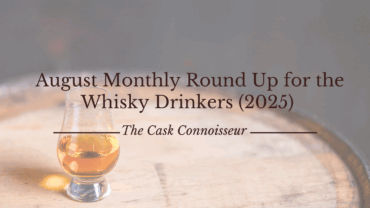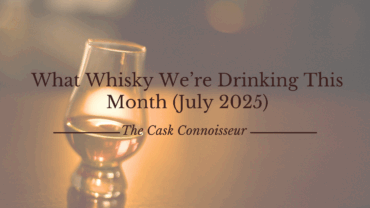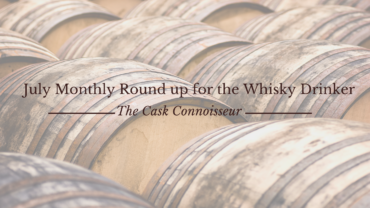This was quite a hard article to put together because a lot of it can be disputed. Whether that is over the lists of whisky or potential health benefits. Our conclusion is that both whisky and chocolate go well together (particularly those finished in sherry casks) and potentially both can have health benefits if consumed in moderation.
But what is moderation?
For whisky it would be one drink per day for women and one to two for men of whisky between 40% and 46% ABV. That would exclude most cask strength whiskies which is a shame, as alcohol content increases the whisky become more robust and deeper in flavours and complexity. For whiskies that take water well, this might not be a problem. Interestingly when we first started drinking whisky some 40 years ago, perceived wisdom was you added water to reduce the alcohol to 30% ABV. Blenders routinely reduce the alcohol content when tasting to 20% ABV or lower.
Too much alcohol cancels out any health benefits. It should be remembered that alcohol is considered the third most prevalent cause of preventable cancers along with its effects on the liver.
For chocolate it is 30-60 grams daily. This is roughly one or two squares of an average chocolate bar made with at least 75% cocoa. Eating too much chocolate can result in weight gain and other health issues due to its high calorie and fat content.
Potential Health Benefits of Whisky
- Rich in Antioxidants – Whisky contains ellagic acid, a naturally occurring polyphenol that has antioxidant properties that can help neutralize free radicals (unstable molecules that can damage cells). Commonly found in strawberries, raspberries and cranberries. If looking for a health benefit, then these berries will be a better option. But heck, will they be as enjoyable?
- Blood Sugar Regulation – Whisky is low in sugar and has “no carbs” but note the alcohol will be converted to carbohydrate or fat by the liver. One 25ml “single” glass of whisky contains around 62 calories apparently, making it one of the best options for those watching their weight or sugar levels. This is complicated by the fact that alcohol reduces blood sugar levels and is harmful to the pancreas in large quantities.
- Heart Health – Perhaps the most controversial of claims. Some studies suggest moderate alcohol intake may reduce the risk of heart disease by increasing HDL (“good”) cholesterol and improving blood flow.
- May Reduce Risk of Dementia – Again controversial but there is some evidence that moderate alcohol intake, including whisky, may be linked to a reduced risk of dementia later in life.
- Potential for Cold Relief – A hot toddy (whisky, hot water, lemon, and honey) can help soothe a sore throat and act as a mild decongestant. The issue is separating out the effects from the whisky or the lemon and honey. Whilst it is an enjoyable “cold remedy” likely you’d get pretty much the same effect without the whisky although the whisky might help you sleep.
- An effect that depending on circumstances maybe beneficial or harmful is the effect of alcohol on blood clotting. Alcohol impacts the ability of blood to clot so might be helpful in preventing certain types of strokes. However, if you’re already taking blood thinning medications then alcohol should be avoided.
When you look at the scientific literature supporting the above claims, most papers are more than 20 years old and there is a clear current trend to emphasise the negative effects of any alcohol. So, the conclusion might be: A little can be okay, maybe even a touch beneficial, but overdoing it flips the script real fast. What you should look out for in choosing a whisky if concerned about health:
- Alcohol Content (ABV) – Choose a whisky around 40–46% ABV. Higher-proof whiskies (like cask-strength ones) have more alcohol per serving, so they can be harder on your liver and raise your calorie intake.
- Additives & Colouring – Scotch malt whisky can legally only add caramel colouring (E150a). There is much debate over whether this is necessary or harmless. It is used to provide consistent colour in brands and the science would say it is perfectly safe. However, if concerned, go for natural-colour, non-chill-filtered whiskies.
- Aging & Additives – Whiskies aged in sherry or wine casks might carry traces of sugar and additives, but again, it’s minimal. Certainly nothing from a science perspective to be concerned about. However, some flavoured or infused whiskies (think honey whisky or cinnamon whisky) have added sugar and flavourings, which potentially make them less healthy from a sugar perspective.
- Grain Type – Single malts (100% malted barley) are the simplest in terms of ingredients. Grain whiskies may include corn, wheat, or rye and can be slightly higher in sugar or carbs before distillation (though that doesn’t usually carry over into the final drink).
- Peat & Smoke – Peated whiskies (like Laphroaig or Ardbeg) contain phenols from the smoking process. There’s no strong evidence they’re unhealthy in the amounts consumed, but if you’re sensitive to smoky compounds, they might irritate you.
- An interesting side issue is the recent trend in using STR casks (shaved, toasted, re-charred). Any health concern is related to the toasting and re-charring, although currently there are no negative health effects recognised, any process that involves heating something can create unwanted chemicals.
Potential Health Benefits of Chocolate
Chocolate contains two potential health promoting compounds – theobromine a naturally occurring alkaloid (methylxanthine) similar to caffeine and the primary source of the bitter taste in chocolate. The other compounds are flavanols which have antioxidant and anti-inflammatory effects. For both, the higher the cocoa content (or darker the chocolate) the greater the amount of these possibly beneficial compounds.
It should be noted from a veterinary perspective that theobromine is toxic to both cats and dogs, as they metabolise the compound much slower than in people. Do not let your pets have access to chocolate.
- Dark Chocolate: Contains the highest amount of theobromine due to its higher cocoa content.
- Milk Chocolate: Contains less theobromine than dark chocolate due to its lower cocoa content.
- White Chocolate: Contains very little to no theobromine, as it doesn’t contain cocoa solids.
Theobromine:
Has some potential health benefits, including lowering blood pressure and improving blood flow. It may also act as a diuretic and have bronchodilating effects. Besides chocolate, theobromine is also found in smaller amounts in tea, coffee, and some other plants.
There are approximately 60 milligrams of theobromine in 28 grams (1 oz) of milk chocolate while the same amount of dark chocolate contains about 200 milligrams . Cocoa beans naturally contain approximately 1% theobromine
Flavanols:
Dark chocolate can offer potential heart health benefits due to the presence of flavonoids, which act as antioxidants. They may help lower blood pressure, reduce inflammation, and improve blood vessel elasticity. There may be a benefit to the lining of the blood vessels, called the endothelium which can be important for heart health.
Other claimed benefits of chocolate include it may help reduce levels of LDL (bad) cholesterol and increase HDL (good) cholesterol. A further claimed benefit by some is consumption, especially in moderation, may be associated with a lower risk of atrial fibrillation, a common heart rhythm disorder. However, any effects on heart health will vary between individuals so pretty much like alcohol there likely are better “therapeutic” options but will they be as enjoyable?
Whisky and Chocolate
Pairing Scotch whisky with chocolate when done right is magic. The key is balancing flavours – matching the whisky’s notes with the right kind of chocolate. We’ve created three lists here. The first is specific whiskies and type of chocolate – you can’t go wrong with these. The other lists are some of the many malts with dominant chocolate notes – get a chocolate hit without the chocolate.
Two quick tips:
- Adding a drop of water or pairing with a piece of 72%+ dark chocolate can unlock even more cocoa depth in many of these drams.
- To enhance chocolate notes in any whisky – Try it with a piece of high-cocoa dark chocolate (around 70–80%) or chocolate-covered espresso beans. It will draw out hidden richness even more.
Specific Whisky Pairings
- GlenDronach 18 Allardice (Sherry Cask Matured) around £185 + Dark Chocolate (70-80%)
- Why it works: Rich, fruity, and sherried whiskies like GlenDronach 18 love deep, bitter dark chocolate. Think dried figs, raisins, and spice meeting the bold cacao.
- A cozy, fireside indulgence.
- Lagavulin 16 (around £82) + Dark Chocolate with Sea Salt
- Why it works: The smoky, peaty powerhouse of Lagavulin meets the salt and intensity of dark chocolate for an unforgettable contrast.
- A stormy night with a plot twist.
- Balvenie DoubleWood 12 (around £54) + Milk Chocolate with Caramel or Toffee
- Why it works: Sweet, approachable, and lightly spicy, this Speyside classic meshes beautifully with creamy milk chocolate.
- Smooth, sweet and charming.
- Glenmorangie Signet (around £185) + Dark Chocolate with Espresso
- Our pick for the biggest chocolate hit – Glenmorangie Signet Reserve (£345)
- Why it works: Signet has chocolate and coffee notes already baked into it. Pairing it with espresso-infused dark chocolate enhances that richness.
- A luxury dessert for a fancy dinner party.
- Oban 14 (around £80) + Orange-Infused Dark Chocolate
- Why it works: Oban has a maritime character with some citrusy, dried fruit notes. Orange dark chocolate complements and lifts those flavours.
- Elegant and adventurous.
Top Scotch Whiskies with Dominant Chocolate Notes
- Glenmorangie Signet (around £185)
- Tasting Notes: Rich dark chocolate, mocha, roasted coffee beans, spiced orange.
- Why it works: Made using “chocolate malt” (heavily roasted barley), giving it an intense, natural chocolate character.
- Legendary among chocolate lovers.
- Aberlour A’Bunadh (around £80)
- Tasting Notes: Dark chocolate, dried fruits, spice, and sherry richness.
- Why it works: Cask-strength beast matured exclusively in Oloroso sherry casks.
- Intense, warming, with that perfect cocoa undertone.
- GlenDronach 18 Allardice (around £185)
- Tasting Notes: Bittersweet dark chocolate, figs, dates, baking spice.
- Why it works: One of the most beloved sherry bombs. Chocolate is a strong, core note.
- Classy and rich, like a dark chocolate truffle.
- BenRiach 12 Sherry Wood (if you can still find it)
- Note: This is not the same as Benriach The Twelve which is a mixture of sherry, port and bourbon casks.
- Tasting Notes: Milk chocolate, spice, dried apricot, nuttiness.
- Why it works: Well-balanced, and the chocolate note shines through thanks to first-fill sherry casks.
- Under-the-radar chocolate pleasure.
- Balvenie 17 DoubleWood (if you can find it -retail expect to pay £350, Auction £180)
- Tasting Notes: Chocolate fudge, oak, spice, dried fruits.
- Why it works: Smooth, rounded, with dessert vibes all the way through.
- Elegant and super sippable.
- Tomatin 18 Year Old (around £115)
- Tasting Notes: Milk chocolate, honey, vanilla, dried fruit.
- Why it works: A gentle highlander that’s surprisingly chocolaty.
- Silky and subtle.
- Glen Scotia Victoriana (around £70-£75)
- Tasting Notes: Dark chocolate, espresso, burnt sugar, oak char.
- Why it works: Bold and slightly smoky with deep cocoa notes.
- Edradour 10 Year Old
- Tasting Notes: Fudge, cocoa powder, rich malt, dried cherries.
- Why it works: Sherry style, like liquid brownie batter.
- Mortlach 16 Year Distiller’s Dram (around £120)
- Tasting Notes: Dark chocolate, leather, plum, roasted nuts.
- Why it works: Meaty, powerful, and cocoa-rich with a savoury edge.
- Glengoyne 18 Year Old (currently only available as 5cl (£11) or 20cl (£42) bottles
- Tasting Notes: Chocolate mousse, treacle, toffee, cinnamon.
- Why it works: Sherry cask elegance with soft, creamy chocolate notes.
Top Budget Scotch Whiskies with Chocolate Notes
- GlenAllachie 12 Year Old
- Price Range: around £60
- Chocolate vibe: Dark chocolate, espresso, heather honey.
- Why it’s great: Billy Walker’s magic with sherry casks. Smooth, rich, and fantastic value.
- Edradour 10 Year Old
- Price Range: around £43
- Chocolate vibe: Chocolate fudge, raisins, rich malt.
- Why it’s great: One of the most dessert-like malts at this price point. Small distillery charm.
- GlenDronach 12 Year Old
- Price Range: around £41
- Chocolate vibe: Cocoa, stewed fruits, spice.
- Why it’s great: A sherried classic with a definite chocolate thread. Solid entry to the GlenDronach range.
- BenRiach The Twelve
- Price Range: around £46
- Chocolate vibe: Milk chocolate, dried fruit, and almond.
- Why it’s great: Triple cask-matured, but still balanced. Light cocoa notes with a sweet twist.
- Tamdhu 12 Year Old
- Price Range: around £50
- Chocolate vibe: Dark chocolate, spice, sultanas.
- Why it’s great: 100% sherry matured. Sleek bottle and even sleeker taste.
- Glen Moray Elgin Classic Sherry Cask Finish
- Price Range: around £28
- Chocolate vibe: Milk chocolate, nutty, caramel.
- Why it’s great: Total sleeper hit. Super affordable, great as a daily dram.
- Auchentoshan Three Wood Price Range: £41
- Chocolate vibe: Chocolate syrup, toffee, espresso.
- Why it’s great: A triple-cask blend (bourbon, Oloroso, PX) that leans rich and dessert-like.
Budget Picks by Chocolate Type:
- Milk chocolate vibes: Glen Moray Sherry Cask, BenRiach Twelve, Auchentoshan Three Wood
- Dark chocolate lovers: GlenAllachie 12, GlenDronach 12, Tamdhu 12
- Dessert whisky fans: Edradour 10, Glen Moray, Auchentoshan
Whisky and chocolate may offer some health perks—but don’t kid yourself. They’re indulgences, and that’s okay. If enjoyed mindfully and moderately, both can be part of a happy, balanced lifestyle.
And when paired well, they deliver something greater than the sum of their parts.





